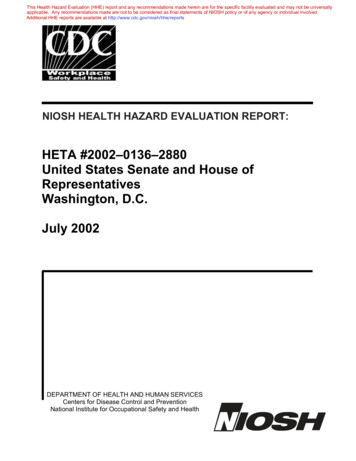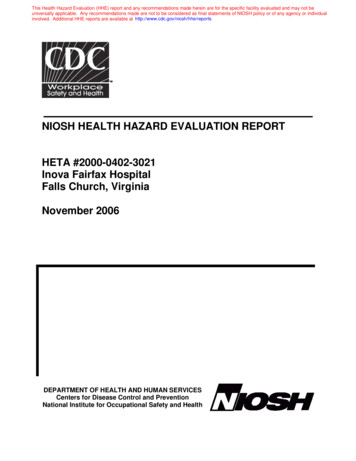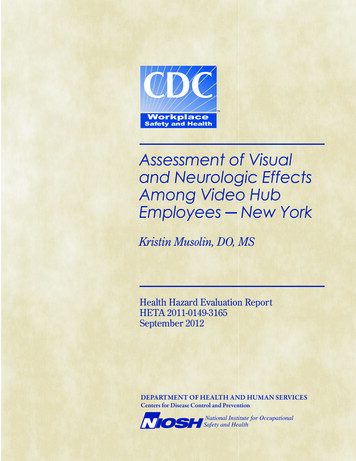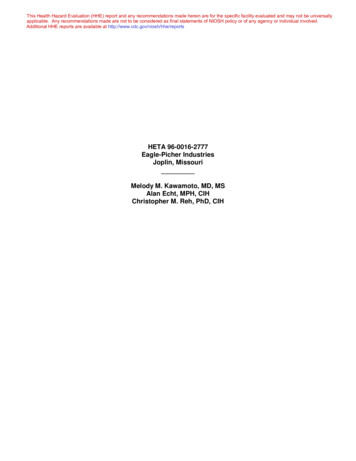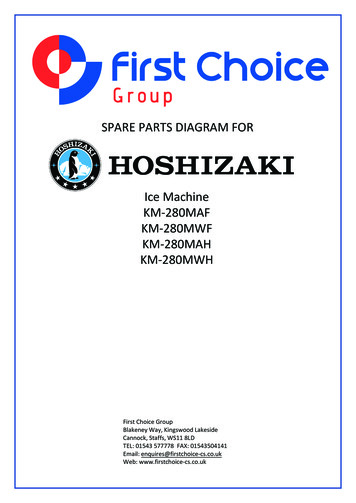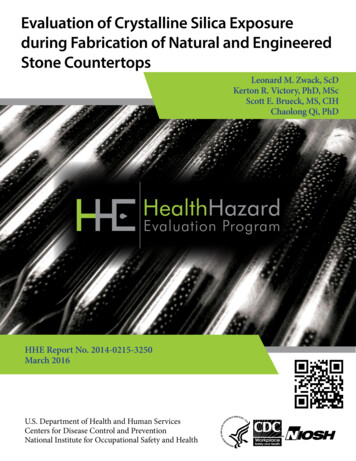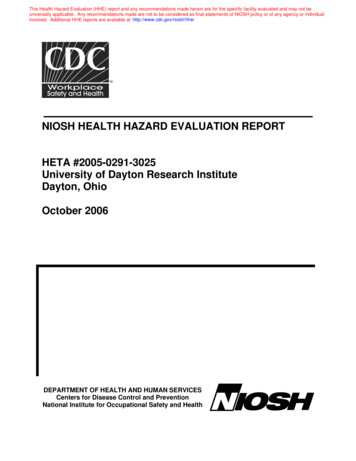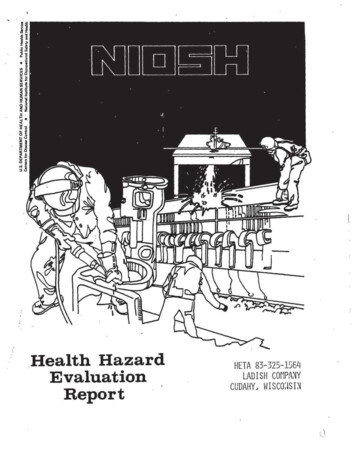
Transcription
This Health Hazard Evaluation (HHE) report and any recommendations made herein are for the specific facility evaluated and may not be universallyapplicable. AnyAny recommendationsrecommendations mademade areare notnot toto bebe consideredconsidered asas finalfinal statementsstatements ofof NIOSHNIOSH policypolicy oror ofof anyany agencyagency oror individualindividual v/niosh/hhe/reportsThis Health Hazard Evaluation (HHE) report and any recommendations made herein are for the specific facility evaluated and may not be universallyapplicable. Any recommendations made are not to be considered as final statements of NIOSH policy or of any agency or individual involved.Additional HHE reports are available at http://www.cdc.gov/niosh/hhe/reportsNIOSH HEALTH HAZARD EVALUATION REPORT:HETA #2001-0536-2864Crumb-Rubber Modified Asphalt Paving:Occupational Exposures andAcute Health EffectsDEPARTMENT OF HEALTH AND HUMAN SERVICESCenters for Disease Control and PreventionNational Institute for Occupational Safety and Health
PREFACEThe Hazard Evaluations and Technical Assistance Branch (HETAB) of the National Institute forOccupational Safety and Health (NIOSH) conducts field investigations of possible health hazards in theworkplace. Upon request, HETAB provides technical and consultative assistance to Federal, State, and localagencies; labor; industry; and other groups or individuals to investigate occupational health hazards and toprevent related trauma and disease.This summary report completes a technical assistance to the Federal Highway Administration (FHWA). Itcontains the summation of the environmental and medical data gathered from a series of seven NIOSH HealthHazard Evaluations (HHEs) conducted between 1994 and 1997. Each of these HHEs measured airborneexposures among paving crews while using crumb– rubber modified asphalt and conventional (non–rubbercontaining) asphalt. Health assessments of acute effects was also conducted at each site. Mention ofcompany names or products does not constitute endorsement by NIOSH.ACKNOWLEDGMENTS AND AVAILABILITY OF REPORTThe main authors of this composite report are Gregory Burr and Allison Tepper (NIOSH, Division ofSurveillance, Hazard Evaluations and Field Studies [DSHEFS]), Larry Olsen (NIOSH, Division of AppliedResearch and Technology [DART]), and Aubrey Miller (Department of Health and HumanServices–[DHHS], U.S. Public Health Service [USPHS], Region VIII]). The statistical analysis wasperformed by Amy Feng (NIOSH, DART). Those responsible for the development of the initial researchprotocol included Aubrey Miller, Kevin Hanley, Larry Olsen, and Ken Wallingford. Individual projectofficers for the HHEs included Kevin Hanley, Aubrey Miller, Daniel Almaguer, Gregory Burr, and GregoryKinnes, all of DSHEFS at the time. Analytical methods were developed by Larry Jaycox, CharlesNeumeister, and Larry Olsen. Laboratory analyses were provided by Ardith Grote, Robert Kurimo, LarryJaycox, Leroy May, Charles Neumeister, and Rosa Key–Schwartz, all of DART. Desktop publishing wasby Robin Smith and Ellen Blythe of DSHEFS. Review and preparation for printing were performed by PennyArthur of the Education and Information Division [EID].Copies of this report have been sent to FHWA officials as well as to employer and employee representativesat each asphalt paving company. Copies have also been furnished to the appropriate OSHA Regional Offices.This report is not copyrighted and may be freely reproduced. Single copies of this report are available fora period of three years from the date of this report. To expedite your request, include a self–addressedmailing label along with your written request to:NIOSH Publications Office4676 Columbia ParkwayCincinnati, Ohio 45226800–356–4674After this time, copies may be purchased from the National Technical Information Service (NTIS) at5825 Port Royal Road, Springfield, Virginia 22161. Information regarding the NTIS stock number may beobtained from the NIOSH Publications Office at the Cincinnati address.ii
Highlights of the NIOSH Health Hazard EvaluationEvaluation of Crumb Rubber Modified Asphalt Paving:Occupational Exposures and Acute Health EffectsBetween 1994 and 1997, the National Institute for Occupational Safety and Health (NIOSH), with help fromthe Federal Highway Administration, studied asphalt paving workers at seven road paving sites in the U.S.Our plan included developing and testing new sampling methods, comparing workers’ exposures to crumbrubber modified (CRM) asphalt and conventional (CONV) asphalt, and evaluating potential acute healtheffects from CRM and CONV asphalt.What NIOSH DidWhat NIOSH Found#PBZ exposures were usually higher duringCRM asphalt paving.# The highest exposures were from jobs near thepaver or asphalt delivery trucks.# Eye, nose, and throat irritation were thesymptoms most frequently reported.# During CRM asphalt paving, eye, nose, andthroat irritation were associated with TP.# Four paving workers had breathing problemswhich may be work-related. All were exposed toCRM asphalt.# Solvent levels were generally very low.Benzene was detected at several sites.# High CO exposures (near the NIOSH ceilinglimit of 200 parts per million) were measured nearsome workers.# Diesel exposures were low.# Benzothiazole was found at all sites. We do notknow if these levels have health effects.# None of the asphalt fume samples tested in thisstudy were mutagenic.We took personal breathing zone (PBZ) airsamples on both CRM and CONV asphalt pavingworkers during their workday.# The jobs that were sampled included truckdumper; paver, screed, and roller operators; rakers;laborers, and site supervisors.# We tested for total particulate (TP), benzenesoluble particulate (BSP), polycyclic aromaticcompounds (PACs), organic sulfur-containingcompounds (OSCs), and benzothiazole. Only TPand BSP have occupational exposure limits.# We sampled for solvents that are sometimesused during asphalt paving.# We sampled for diesel exhaust and carbonmonoxide (CO) at the paving site.# We checked if the asphalt fume was mutagenicby testing it on bacteria.# We asked paving and non-paving workers tocomplete a questionnaire about symptoms such aseye, nose, and throat irritation.# We tested the workers’ breathing capacityduring their work day.#ConclusionOur findings suggest that CRM exposures are potentially more hazardous than CONV exposures. Regardlessof the type of asphalt being used, however, skin contact with asphalt and any clean-up solvents should beavoided and exposure to asphalt fume should be reduced whenever possible by the use of engineering andadministrative controls.What To Do For More Information:We encourage you to read the full report. If youwould like a copy, either ask your health andsafety representative to make you a copy or call1-513-841-4252 and ask forHETA Report # 2001-0536-2864Highlights of the HHE Reportiii
NIOSH Summary Report ofCrumb–Rubber Modified Asphalt Paving:Occupational Exposures andAcute Health EffectsGregory BurrAllison TepperAmy FengLarry OlsenAubrey MillerSUMMARYIn 1991, Congress enacted the Intermodal Surface Transportation Efficiency Act (ISTEA), which required eachstate to use a minimum quantity of "crumb–rubber modified" (CRM) hot–mix asphalt (HMA) paving material.Because of industry and labor concerns over the lack of available information on the environmental and humanhealth effects resulting from the use of CRM–HMA, along with the higher initial cost of using this paving material,a temporary legislative moratorium was passed and the U.S. Environmental Protection Agency (EPA) and the U.S.Department of Transportation, Federal Highway Administration (FHWA) were directed by Congress to evaluatethe potential environmental and human health effects associated with the use of CRM asphalt. The NationalHighway System Designation Act of 1995 eliminated the mandate requiring the use of CRM asphalt but continuedto require research concerning CRM asphalt paving.In June 1994, the National Institute for Occupational Safety and Health (NIOSH) entered into an InteragencyAgreement with the FHWA to evaluate occupational exposures among asphalt road workers. A study protocoldeveloped by NIOSH included the following objectives:P Develop and field test new methods to assess asphalt fume exposures.P Characterize and compare occupational exposures to CRM asphalt and conventional (CONV) asphalt.P Evaluate potential health effects associated with CRM asphalt and CONV asphalt.The protocol called for up to eight individual site evaluations in different regions of the country. The intent wasto allow NIOSH investigators to observe different asphalt pavement formulations, climatic conditions, and pavingtechniques. Seven site evaluations were completed between 1994 and 1997. The environmental and medicalresults discussed collectively in this report have been individually published in the following seven NIOSH HealthHazard Evaluation (HHE) final reports:PPPPPPPHETA 94–0365–2563, Spartan Paving Company, Lansing, Michigan (March 1996)HETA 94–0408–2564, Granite Construction Company, Sacramento, California (March 1996)HETA 95–0118–2565, Martin Paving Company, Yeehaw Junction, Florida (March 1996)HETA 95–0307–2602, Koester Equipment Company, Evansville, Indiana (December 1996)HETA 96–0072–2603, Staker Paving Company, Casa Grande, Arizona (December 1996)HETA 96–0130–2619, Sim J. Harris Company, San Diego, California (December 1996)HETA 97–0232–2674, Barton–Trimount, Stoughton, Massachusetts (February 1998)A new NIOSH method which simultaneously sampled for total particulate (TP) and benzene soluble particulate(BSP) was developed.1 Polycyclic aromatic compounds (PACs) were sampled using a new analytical method thativ
included a PAC370 group (2–3 ring compounds, many of which have irritative effects) and a PAC400 group (4– andmore ring compounds, some of which are carcinogenic).2 In addition to PACs, organic sulfur–containingcompounds (OSCs, present in crude petroleum or from the addition of rubber) and benzothiazole (asulfur–containing compound present in rubber tires), were also sampled using a newly developed sampling andanalytical method.3 These compounds were of interest for their potential for respiratory irritation (OSCs) or fortheir use as an indicator of other chemicals present in CRM asphalt fume (OSCs and benzothiazole). Samples werecollected for volatile organic compounds (VOCs, including toluene, xylene, benzene, and methyl isobutyl ketone[MIBK], and total VOCs [TVOCs, quantified as Stoddard solvent]. Both elemental carbon (EC) and organiccarbon (OC) were measured and the ratio to total carbon (TC) was compared to ascertain if diesel exhaust was alikely contributor to the air contaminants measured at each site. Area air samples were collected to determine therespirable particulate concentrations. Direct–reading instruments were used to measure carbon monoxide (CO),hydrogen sulfide (H2S), sulfur dioxide (SO2), and ozone. Finally, high volume air samples of both CRM andCONV asphalt fume were collected from the emissions of asphalt cement storage tanks located at the hot–mixplants and analyzed to determine their mutagenic potential.Area air sample results revealed that concentrations of TP, respirable particulate, BSP, PACs, OSCs, andbenzothiazole varied between sampling locations and survey days but were generally higher during the CRMasphalt paving than during CONV asphalt paving. In all but two samples, the PAC370 concentrations were greaterthan the PAC400 concentrations. All of the air samples collected for EC above the screed auger on the paver vehiclehad concentrations above the background levels. Since diesel exhaust has been reported to contain EC levelsbetween 60 to 80% of the TC, the relatively low EC:TC ratios measured at all but one of the sites imply that dieselexhaust was not substantially contributing to the air sampling results.4 None of the asphalt fume samples werefound to be mutagenic using a spiral Salmonella mutagenicity assay.Over 50 VOCs were detected in the asphalt emissions, but only the highest peaks were analyzed quantitatively.Although higher concentrations of toluene, xylene, and MIBK were measured during CRM asphalt paving, allconcentrations were generally less than 1 part per million (ppm). Concentrations of TVOCs (as Stoddard solvent)ranged up to 224 milligrams per cubic meter (mg/m3). The NIOSH Recommended Exposure Limit (REL) forStoddard solvent is 350 mg/m3 for up to a 10–hour time–weighted average (TWA). Benzene was detected near thescreed auger in area samples collected during CRM asphalt paving in concentrations up to 0.77 ppm. Lower, butstill detectable, concentrations of benzene were measured during CONV paving. NIOSH classifies benzene as anoccupational carcinogen with a REL of 0.1 ppm, 8–hour TWA, noting that exposures should be controlled to thelowest feasible level (LFL).All personal breathing–zone (PBZ) TP exposures were below 1.4 mg/m3, expressed as TWAs for the workday.These PBZ results cannot be compared to the NIOSH REL for asphalt fume of 5 mg/m3 for a 15–minute exposuresince the samples in this study were collected over the full work–shift. For six of the eight job categories studied,the geometric mean (GM) PBZ exposures to TP during CRM asphalt paving (range 0.17 to 0.48 mg/m3) was higherthan during CONV asphalt paving (range 0.06 to 0.81 mg/m3). However, only the screed operators and rolleroperators were exposed to significantly more TP during CRM asphalt paving than during CONV asphalt paving(p # 0.01).The GM BSP concentrations were higher for four of the six jobs evaluated during CRM asphalt paving (range 0.02to 0.25 mg/m3) compared to CONV asphalt application (range 0.02 to 0.44 mg/m3). The average concentration byjob was below the American Conference of Governmental Industrial Hygienists (ACGIH) Threshold Limit Value(TLV ) of 0.5 mg/m3 , 8–hour TWA for asphalt fume. Some paver operators and truck dumpers, however, hadindividual exposures above the TLV. The BSP concentration differences by asphalt type were not significantlydifferent for any job category.The GM PBZ concentrations for PAC370, PAC400, OSCs, and benzothiazole were higher during CRM asphalt pavingthan CONV paving. As was observed in the area air samples, PAC370 concentrations exceeded PAC400concentrations. Of the jobs evaluated, only the screed and roller operators had significantly higher PAC exposuresduring CRM asphalt paving when compared to CONV paving (p # 0.01). The paver, screed, and roller operatorsv
were all exposed to significantly more OSC during CRM paving than CONV paving (p # 0.01). All paving jobswere exposed to significantly more benzothiazole during CRM paving than during CONV paving (p # 0.01). Withthe exception of the first survey site in California, benzothiazole was only detected during CRM asphalt paving.There are currently no occupational exposure limits for PAC370, PAC400, OSCs, or benzothiazole, and littleoccupational exposure data exists for comparison beyond what is reported in this study.TWA CO area concentrations ranged up to 24 ppm during paving, with peak values as high as 910 ppm. TheNIOSH REL is 35 ppm for up to an 8–hour TWA, with a ceiling limit of 200 ppm. Concentrations of H2S, SO2,and ozone were well below their respective occupational exposure limits.Prior studies of the acute toxic effects of asphalt fume exposures in workers have repeatedly reported eye and upperrespiratory tract (nasal) irritation.5 These health effects have been well documented in asphalt road pavers andtypically appear to be mild and transient. In this study, both CRM and CONV asphalt workers experiencedsymptoms (eye, nose, and throat irritation being most commonly reported), but the occurrence rates of thesesymptoms were higher among the CRM asphalt–exposed group. With one exception during CRM asphalt paving,specific contaminant concentrations did not differ between days when eye, nose, or throat irritation or cough werepresent and days when these symptoms were absent. Concentrations of TP were nearly twice as high on days wheneye, nose, or throat irritation was present compared to those days when eye, nose, or throat irritation was notreported (p # 0.01). During CONV asphalt paving, concentrations of TP, BSP, and PACs were significantly higheron days when eye, nose, or throat irritation was present (p # 0.05). Concentrations of BSP, OSC, and benzothiazolewere significantly higher on days when cough was present (p # 0.05). Although an exposure–response relationshiphas not been established in this study, the identification of health effects related to personal exposures tocontaminants (measured as TP and BSP) during both CRM and CONV asphalt paving indicates that such arelationship may exist.Exposures to TP, BSP, PACs, and OSCs were generally higher during CRM asphalt paving comparedto CONV asphalt paving. The highest PBZ exposures were measured on paver and screed operators, andtruck dumpers. Screed and roller operators were exposed to significantly more TP during CRM pavingthan during CONV paving, while no significant difference existed between CRM and CONV paving forBSP exposures. Workers on all paving jobs had significantly higher exposures to benzothiazole duringCRM paving. Symptom occurrence rates were higher during CRM asphalt paving, and eye, nose, andthroat irritation were the three most frequently reported symptoms among all asphalt fume exposedworkers. At some paving sites, worker exposures to CO exceeded the NIOSH ceiling limit of 200 ppm.Area air samples measured generally low concentrations of selected VOCs at the paving sites, with theexception of benzene. Recommendations are included for lowering the asphalt application temperature;prohibiting eating, drinking, and smoking near asphalt fume emissions; providing washing and clothes–changing facilities at the work site; reducing the use of diesel fuel for tool cleaning; and wearingprotective clothing or appropriate sun screen to protect exposed skin from harmful effects of sun exposurewhen working outdoors.Keywords: SIC 1611 (Highway and Street Construction), asphalt fume, bitumen, crumb–rubber modified, CRM,recycled tires, paving, polycyclic aromatic compounds, PACs, polynuclear aromatic hydrocarbons, PAH, totalparticulate, respirable particulate, benzene soluble particulate, volatile organic compounds, TVOC, elementalcarbon, eye irritation, throat irritation, respiratory irritation, mutagenicity.vi
TABLE OF CONTENTSPreface . . . . . . . . . . . . . . . . . . . . . . . . . . . . . . . . . . . . . . . . . . . . . . . . . . . . . . . . . . . . . . . . . . . . . . . . . . . . iiAcknowledgments and Availability of Report . . . . . . . . . . . . . . . . . . . . . . . . . . . . . . . . . . . . . . . . . . . . . . . . iiHighlights of the HHE Report . . . . . . . . . . . . . . . . . . . . . . . . . . . . . . . . . . . . . . . . . . . . . . . . . . . . . . . . . . . iiiSummary . . . . . . . . . . . . . . . . . . . . . . . . . . . . . . . . . . . . . . . . . . . . . . . . . . . . . . . . . . . . . . . . . . . . . . . . . . . ivIntroduction . . . . . . . . . . . . . . . . . . . . . . . . . . . . . . . . . . . . . . . . . . . . . . . . . . . . . . . . . . . . . . . . . . . . . . . . . 1Background . . . . . . . . . . . . . . . . . . . . . . . . . . . . . . . . . . . . . . . . . . . . . . . . . . . . . . . . . . . . . . . . . . . . . . . . . 1Paving Process Overview . . . . . . . . . . . . . . . . . . . . . . . . . . . . . . . . . . . . . . . . . . . . . . . . . . . . . . . . . . . . . . . 2Environmental Study Design . . . . . . . . . . . . . . . . . . . . . . . . . . . . . . . . . . . . . . . . . . . . . . . . . . . . . . . . . . . .Area Air Sampling at the Paving Sites . . . . . . . . . . . . . . . . . . . . . . . . . . . . . . . . . . . . . . . . . . . . . . . . . .Area Air Sampling for Mutagenicity Testing . . . . . . . . . . . . . . . . . . . . . . . . . . . . . . . . . . . . . . . . . . . . .Personal Air Samples . . . . . . . . . . . . . . . . . . . . . . . . . . . . . . . . . . . . . . . . . . . . . . . . . . . . . . . . . . . . . .Other Site Information . . . . . . . . . . . . . . . . . . . . . . . . . . . . . . . . . . . . . . . . . . . . . . . . . . . . . . . . . . . . . .33444Medical Study Design . . . . . . . . . . . . . . . . . . . . . . . . . . . . . . . . . . . . . . . . . . . . . . . . . . . . . . . . . . . . . . . . .Data Collection . . . . . . . . . . . . . . . . . . . . . . . . . . . . . . . . . . . . . . . . . . . . . . . . . . . . . . . . . . . . . . . . . . .Data Analysis . . . . . . . . . . . . . . . . . . . . . . . . . . . . . . . . . . . . . . . . . . . . . . . . . . . . . . . . . . . . . . . . . . . .Comparisons between Exposure Groups . . . . . . . . . . . . . . . . . . . . . . . . . . . . . . . . . . . . . . . . . . . . .Relationship between Symptoms and Specific Air Contaminants . . . . . . . . . . . . . . . . . . . . . . . . . . .44556Evaluation Criteria . . . . . . . . . . . . . . . . . . . . . . . . . . . . . . . . . . . . . . . . . . . . . . . . . . . . . . . . . . . . . . . . . . . . 6Asphalt Fumes (Petroleum) . . . . . . . . . . . . . . . . . . . . . . . . . . . . . . . . . . . . . . . . . . . . . . . . . . . . . . . . . . 6Environmental Study Results . . . . . . . . . . . . . . . . . . . . . . . . . . . . . . . . . . . . . . . . . . . . . . . . . . . . . . . . . . . .Area Air Samples at Paving Sites . . . . . . . . . . . . . . . . . . . . . . . . . . . . . . . . . . . . . . . . . . . . . . . . . . . . . .Area Air Sampling for Mutagenicity Testing . . . . . . . . . . . . . . . . . . . . . . . . . . . . . . . . . . . . . . . . . . . . .Personal Air Samples . . . . . . . . . . . . . . . . . . . . . . . . . . . . . . . . . . . . . . . . . . . . . . . . . . . . . . . . . . . . . .Other Site Information . . . . . . . . . . . . . . . . . . . . . . . . . . . . . . . . . . . . . . . . . . . . . . . . . . . . . . . . . . . . . .77889Medical Study Results . . . . . . . . . . . . . . . . . . . . . . . . . . . . . . . . . . . . . . . . . . . . . . . . . . . . . . . . . . . . . . . .Demographics . . . . . . . . . . . . . . . . . . . . . . . . . . . . . . . . . . . . . . . . . . . . . . . . . . . . . . . . . . . . . . . . . . .Association between Symptoms and Exposure . . . . . . . . . . . . . . . . . . . . . . . . . . . . . . . . . . . . . . . . . . .Comparisons between Exposure Groups . . . . . . . . . . . . . . . . . . . . . . . . . . . . . . . . . . . . . . . . . . . .Relationship between Symptoms and Specific Air Contaminants . . . . . . . . . . . . . . . . . . . . . . . . . .Peak Flow . . . . . . . . . . . . . . . . . . . . . . . . . . . . . . . . . . . . . . . . . . . . . . . . . . . . . . . . . . . . . . . . . .101010101111Discussion . . . . . . . . . . . . . . . . . . . . . . . . . . . . . . . . . . . . . . . . . . . . . . . . . . . . . . . . . . . . . . . . . . . . . . . . .Sampling Techniques . . . . . . . . . . . . . . . . . . . . . . . . . . . . . . . . . . . . . . . . . . . . . . . . . . . . . . . . . . . . .Occupational Exposures . . . . . . . . . . . . . . . . . . . . . . . . . . . . . . . . . . . . . . . . . . . . . . . . . . . . . . . . . . .Health Effects . . . . . . . . . . . . . . . . . . . . . . . . . . . . . . . . . . . . . . . . . . . . . . . . . . . . . . . . . . . . . . . . . . .11111213Conclusions . . . . . . . . . . . . . . . . . . . . . . . . . . . . . . . . . . . . . . . . . . . . . . . . . . . . . . . . . . . . . . . . . . . . . . . . 13Sampling Techniques . . . . . . . . . . . . . . . . . . . . . . . . . . . . . . . . . . . . . . . . . . . . . . . . . . . . . . . . . . . . . 14
Occupational Exposures . . . . . . . . . . . . . . . . . . . . . . . . . . . . . . . . . . . . . . . . . . . . . . . . . . . . . . . . . . . 14Health Effects . . . . . . . . . . . . . . . . . . . . . . . . . . . . . . . . . . . . . . . . . . . . . . . . . . . . . . . . . . . . . . . . . . . 15Recommendations . . . . . . . . . . . . . . . . . . . . . . . . . . . . . . . . . . . . . . . . . . . . . . . . . . . . . . . . . . . . . . . . . . . 15References . . . . . . . . . . . . . . . . . . . . . . . . . . . . . . . . . . . . . . . . . . . . . . . . . . . . . . . . . . . . . . . . . . . . . . . . . 15Appendix A . . . . . . . . . . . . . . . . . . . . . . . . . . . . . . . . . . . . . . . . . . . . . . . . . . . . . . . . . . . . . . . . . . . . . . . . 38Glossary of Terms . . . . . . . . . . . . . . . . . . . . . . . . . . . . . . . . . . . . . . . . . . . . . . . . . . . . . . . . . . . . . . . . . . . 40viii
INTRODUCTIONApproximately 285 million tires are discarded inthe United States each year, posing significant health,fire, and solid waste management problems.6 Onemeans of reducing these problems is to use scraptire rubber in highway paving materials. In 1991,Congress enacted the Intermodal SurfaceTransportation Efficiency Act (ISTEA), whichrequired each state to use a minimum quantity of"crumb–rubber modified" (CRM) hot–mix asphalt(HMA) paving material, beginning at 5% of theHMA used in federally funded paving in 1993, andincreasing to 20% in 1997 and thereafter.Because of concerns over the lack of availableinformation on the environmental and human healtheffects resulting from the use of CRM–HMA, alongwith the higher initial cost of using this pavingmaterial, a temporary legislative moratorium waspassed which precluded enforcement of the penaltyprovisions of the ISTEA legislation. It also directedthe U.S. Environmental Protection Agency (EPA)and the U.S. Department of Transportation, FederalHighway Administration (FHWA) to evaluate thepotential environmental and human health effectsassociated with the use of CRM asphalt. Althoughthe National Highway System Designation Act of1995 eliminated the mandate requiring the use ofCRM asphalt, it still required research concerningCRM asphalt paving.BACKGROUNDIn June 1994, the National Institute for OccupationalSafety and Health (NIOSH) entered into anInteragency Agreement with the FHWA to evaluateoccupational exposures among asphalt workers. Astudy protocol was developed by NIOSHinvestigators to address the following goals:P Develop and field test new methods to assessasphalt fume exposures.P Characterize and compare occupationalexposures to CRM asphalt and conventional (CONV)asphalt.Health Hazard Evaluation Report No. 2001-0536-2864Evaluate potential acute health effects associatedwith CRM asphalt and CONV asphalt.PThe initial protocol called for up to eight individualsite evaluations, in different regions of the country.The intent was to allow NIOSH investigators accessto different asphalt pavement formulations, climaticconditions, and paving techniques. A total of sevensite evaluations were completed between 1994 and1997 (Figure 1). A description of the pavingcharacteristics and weather conditions at the surveysites is presented in Table 1. Although the goal ateach site was to evaluate four consecutive days ofpaving by the same crew (two days of CRM asphalt,and two days of CONV asphalt formulated from theFigure 1:Survey SitesLansing, MIYeehaw Junction, FLCasa Grande, AZBoston, MASacramento, CAEvansville, INSan Diego, CAsame supply of asphalt cement), in a few instancesthere was a gap of several days to several weeksbetween paving projects.The environmental and medical results discussedcollectively in this report have been individuallypublished in the following seven NIOSH HealthHazard Evaluation (HHE) final reports:P HETA 94–0365–2563, Spartan PavingCompany, Lansing, Michigan (March 1996)7P HETA 94–0408–2564, Granite ConstructionCompany, Sacramento, California (March 1996)8P HETA 95–0118–2565, Martin Paving Company,Yeehaw Junction, Florida (March 1996)9P HETA 95–0307–2602, Koester EquipmentCompany, Evansville, Indiana (December 1996)10Page 1
P HETA 96–0072–2603, Staker Paving Company,Casa Grande, Arizona (December 1996)11P HETA 96–0130–2619, Sim J. Harris Company,San Diego, California (December 1996)12P HETA 97–0232–2674, Barton–Trimount,Stoughton, Massachusetts (February 1998)13PAVING PROCESSOVERVIEWThere are three basic steps in constructing an asphaltpavement – manufacture of the HMA, placement ofthe mix onto the ground, and compaction. Theasphalt mix contains two primary ingredients: abinder (which is typically an asphalt cement) and anaggregate (a mixture of coarse and fine stones,gravel, sand, and other mineral fillers).Asphalt cement is typically received from a refineryby tractor trailer tankers and is transferred into heatedstorage tanks at the HMA plant. At the HMA plant,aggregate of different materials and sizes is blendedand dried, then coated with a thin film of asphaltcement to produce a homogeneous paving mixture.This finished HMA paving mixture, which is keptheated so that it can be easily applied andcompacted, is eventually dispensed into trucks andhauled to the paving site where the followingequipment is typically used:P Tack truck: A vehicle which precedes thepaver and applies a low viscosity asphalt ("tack"coat) to the roadway to improve adhesion of theHMA. This equipment was seen in use only brieflyat one paving site. This tack truck driver wasmonitored for total particulate (TP).dumper” to monitor the emptying of the deliverytruck and the placement of the windrow in front ofthe paving vehicle); or (3) conveying the mix with amaterial transfer vehicle. All three techniques wereevaluated in this study. Each study site had onepaver operator. Four of the seven sites used truckdumpers.P Screed: Located at the rear of the paver, thescreed distributes the HMA onto the road to apreselected width and depth and grades the HMAmix to the appropriate slope as the paving vehiclemoves forward. Each study site had one or t
the Federal Highway Administration, studied asphalt pa ving workers at seven road paving sites in the U.S. Our plan included developing and testing new sampli ng methods, comparing workers' exposures to crumb-rubber modified (CRM) asphalt and conventional (CONV) asphalt, and evaluating potential acute health effects from CRM and CONV asphalt.
